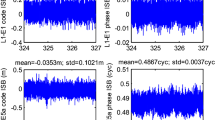Abstract
Extensive studies on signal noise analysis of Global Navigation Satellite Systems (GNSS) receivers are mainly based on zero and/or short baselines where a pair of receivers is required. This paper develops a new signal noise assessment method for a standalone GNSS receiver. In this new method, the time differenced geometry-free (\( \Delta \)GF) model is formed, where the residual ionospheric delay and multipath remain. In order to eliminate these systematic trend biases, the second-order polynomial fitting is used. Then the mixed autoregressive moving average (ARMA) model is further applied to capture this stationary and time-correlated time series. As a result, the pure random noise of \( \Delta \)GF is obtained, which is finally used to assess the precision of receiver signal in terms of the error propagation law. The performance of this new method is numerically tested by using 10 sets of data and compared with the methods of zero and short baselines. The results indicate that the new method is able to assess both the phase and code precision of a standalone receiver, and the conclusions are consistent to those from the methods of zero and short baselines. Since again the new method needs only one receiver, it could be implemented in more applications than the traditional methods, especially in precise point positioning.










Similar content being viewed by others
References
Afifi A, El-Rabbany A (2013) Stochastic modeling of Galileo E1 and E5a signals. Int J Eng Innov Technol IJEIT 3:188–192
Amiri-Simkooei A, Tiberius C (2007) Assessing receiver noise using GPS short baseline time series. GPS Solut 11:21–35
Bona P (2000) Precision, cross correlation, and time correlation of GPS phase and code observations. GPS Solut 4:3–13
Bona P, Tiberius C (2000) An experimental comparison of noise characteristics of seven high-end dual frequency GPS receiver-sets. In: Position location and navigation symposium, IEEE 2000, IEEE, pp 237–244
Box GE, Jenkins GM, Reinsel GC, Ljung GM (1994) Time series analysis: forecasting and control. Wiley, Hoboken
Chatfield C (1984) The analysis of time series: an introduction. CRC Press, Boca Raton
de Bakker PF, van der Marel H, Tiberius CC (2009) Geometry-free undifferenced, single and double differenced analysis of single frequency GPS, EGNOS and GIOVE-A/B measurements. GPS Solut 13:305–314
de Bakker PF, Tiberius CC, van der Marel H, van Bree RJ (2012) Short and zero baseline analysis of GPS L1 C/A, L5Q, GIOVE E1B, and E5aQ signals. GPS Solut 16:53–64
El-Rabbany A (1994) The effect of physical correlations on the ambiguity resolution and accuracy estimation in GPS differential positioning. Department of Geodesy and Geomatics Engineering, University of New Brunswick, Fredericton
Euler H, Goad C (1991) On optimal filtering of GPS dual frequency observations without using orbit information. Bull Geod 65:130–143
Ge M, Gendt G, Rothacher M, Shi C, Liu J (2008) Resolution of GPS carrier-phase ambiguities in precise point positioning (PPP) with daily observations. J Geod 82:389–399
Hamilton J (1994) Time series analysis. Princeton University Press Princeton, Princeton
Han S (1997) Quality-control issues relating to instantaneous ambiguity resolution for real-time GPS kinematic positioning. J Geod 71:351–361
Hofmann-Wellenhof B, Lichtenegger H, Wasle E (2007) GNSS–global navigation satellite systems: GPS, GLONASS, Galileo, and more. Springer Science & Business Media
Howind J, Kutterer H, Heck B (1999) Impact of temporal correlations on GPS-derived relative point positions. J Geod 73:246–258
Langley RB (1997) GPS receiver system noise. GPS World 8:40–45
Leick A, Rapoport L, Tatarnikov D (2015) GPS satellite surveying. Wiley, Hoboken
Li B (2016) Stochastic modeling of triple-frequency BeiDou signals: estimation, assessment and impact analysis. J Geod 90:1–18
Nolan J, Gourevitch S, Ladd J (1992) Geodetic processing using full dual band observables. Proc IONGPS 92:1033–1041
Rodríguezpérez JR, Álvarez MF, Sanzablanedo E (2007) Assessment of low-cost GPS receiver accuracy and precision in forest environments. J Surv Eng 133:159–167
Schwarz G (1978) Estimating the dimension of a model. Ann Stat 6:461–464
Teunissen P (1995) The least-squares ambiguity decorrelation adjustment: a method for fast GPS integer ambiguity estimation. J Geod 70:65–82
Tiberius C, De Bakker P, Marel H, van Bree R (2001) Geometry-free analysis of GIOVE-A/B E1-E5a, and GPS L1-L5 measurements. In: Proceedings of the 22nd international technical meeting of the satellite division of the institute of navigation (ION GNSS 2009), pp 2911–2925
Van der Marel H, de Bakker P, Tiberius C (2009) Zero, single and double difference analysis of GPS, EGNOS and GIOVE-A/B pseudorange and carrier phase measurements. In: Proceedings of ENC GNSS
Verhagen S, Li B (2012) LAMBDA software package: Matlab implementation, version 3.0. Delft University of Technology and Curtin University, Perth, Australia
Wang J, Satirapod C, Rizos C (2002) Stochastic assessment of GPS carrier phase measurements for precise static relative positioning. J Geod 76:95–104
Welford B (1962) Note on a method for calculating corrected sums of squares and products. Technometrics 4:419–420
Zumberge J, Heflin M, Jefferson D et al (1997) Precise point positioning for the efficient and robust analysis of GPS data from large networks. J Geophys Res Solid Earth 1978–2012(102):5005–5017
Acknowledgements
This study is sponsored by The National Key Research and Development Program of China (2016YFB0501802), The National Natural Science Funds of China (41574023, 41374031) and The National Natural Science Foundation of China (41622401). The second author is also supported by the Fund of Youth 1000-Plan Talent Program of China. The reviewers and editors are acknowledged for their constructive comments.
Author information
Authors and Affiliations
Corresponding author
Rights and permissions
About this article
Cite this article
Zhang, Z., Li, B., Shen, Y. et al. A noise analysis method for GNSS signals of a standalone receiver. Acta Geod Geophys 52, 301–316 (2017). https://doi.org/10.1007/s40328-016-0189-x
Received:
Accepted:
Published:
Issue Date:
DOI: https://doi.org/10.1007/s40328-016-0189-x




